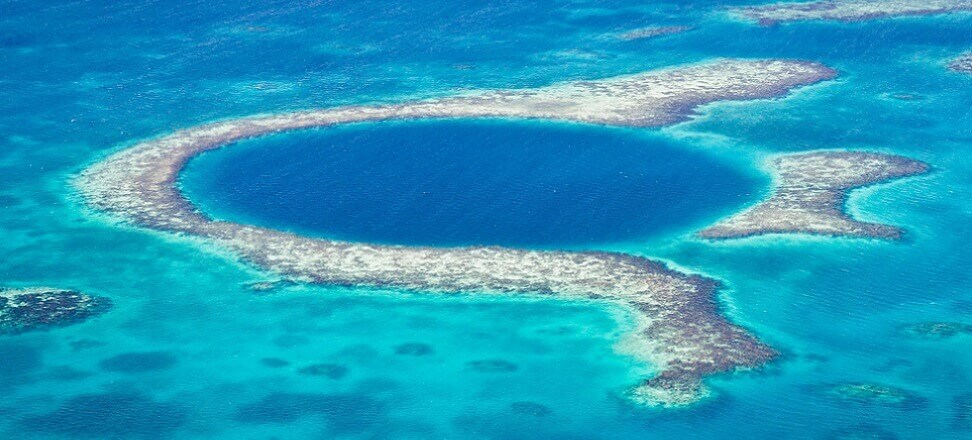From the world, In this issue, Issue 13/2024
Great Blue Hole: The Great Blue Hole in the Ocean
Deep in the turquoise waters, off the coast of Belize, hides one of the most mysterious and awe-inspiring places on Earth – the Great Blue Hole. This giant underwater cave has attracted the attention of divers and scientists alike from around the world. What makes it so special? Discover ten fascinating facts about this geological gem, which not only captivates with its extraordinary beauty, but also hides secrets dating back thousands of years into the past. Dive into the mysteries of the underwater world and learn the stories that lie beneath the surface of Belize’s blue waters.
Geological genesis
Great Blue Hole was formed as a limestone cave during the last ice ages, about 150,000 years ago. Up to 15,000. years ago, when the sea level was much lower than today. Geological analyses show that the cave was formed at a time when the ground water contained much lower amounts of carbonic acid than today, which promoted the dissolution of the limestone bedrock and the formation of huge underground chambers. After the end of the Ice Age, about 14,000. Years ago, the melting of glaciers caused the sea level to rise and flood these caves with water, leading to the collapse of their roofs and the formation of a huge underwater cavity, which we know today as the Great Blue Hole.
Characteristics
The Great Blue Hole, measuring about 318 meters in diameter and more than 120 meters deep, is one of the largest known formations of its kind in the world, and its almost perfectly circular shape is an exceptional rarity. Great Blue Hole is part of the Lighthouse Reef atoll, which in turn is part of the Mesoamerican coral reef system – the second largest in the world.
UNESCO World Heritage
Great Blue Hole, as part of the Lighthouse Atoll Marine Reserve, was designated a UNESCO World Heritage Site in 1996. The reserve protects a variety of marine ecosystems, including coral reefs, mangroves, lagoons and diverse marine species. It also provides important habitat for many endangered species, both marine and avian. UNESCO recognizes the importance of the area not only for its unique geological features, but also for its role in maintaining the biodiversity and health of global marine ecosystems.
Discovery by Jacques Cousteau
Jacques Cousteau, the famous ocean explorer, put the Blue Hole on the tourist map in 1971, when he recognized it as one of the world’s best dive sites. His research contributed to global interest in the location. Cousteau and the crew of the ship Calypso conducted numerous dives and surveys to discover not only the beauty but also the scientific value of the site. Cousteau, armed with the most modern diving equipment of his time, descended to depths that were previously unreachable by humans. His discoveries attracted the attention of the media and researchers from around the world, making the Great Blue Hole an icon in the world of underwater exploration.
Popular dive site
For divers, the Great Blue Hole is an iconic site. There are various stalactite and stalagmite formations that were formed before the cave was flooded. Various species of sharks can also be found, such as hammerheads, dwarf sharks and reef sharks. The cave guarantees an unparalleled diving experience. The depth, clarity of the water and unique rock formations provide an unforgettable experience. This place attracts both professional divers and amateurs seeking adventure. Diving in the Great Blue Hole is not only a journey into the depths of geological history, but also an encounter with fascinating marine fauna.
Unique ecosystems
Beneath the surface of the Great Blue Hole, one of the most puzzling natural features on Earth, is a unique ecosystem that evolved under conditions of extremely low oxygen levels. These anoxic layers create a habitat for specialized microorganisms, such as sulfidogenic bacteria or methanogenic archaeons, which have adapted to survive in harsh, oxygen-poor conditions. The research they are undergoing provides valuable information not only about adaptability, but also has implications for astrobiology, suggesting how life could exist on other planets.
Geological secrets
Diving in the Great Blue Hole allows exploration of geological layers that date back hundreds of thousands of years. Stalagmites and stalactites discovered at depths of about 40 meters suggest that the cave was once dry. These rock formations are evidence of past climatic and geological changes. Such discoveries help scientists understand the Earth’s history and the processes that shaped its current landscape. Analysis of fossils and sediments from the Great Blue Hole provides information on sea level changes, climatic conditions and seismic activity in the region. These data are crucial for reconstructing the paleoclimate. Geological research in the Great Blue Hole is also important for understanding long-term climate trends and their impact on global ecosystems.
Scientific expeditions
Great Blue Hole attracts many scientific expeditions that study not only the geology of the cave, but also its unique ecosystem. Scientists provide valuable information about the Earth’s climate thousands of years ago. One of the most famous expeditions took place in 2018, when a group of researchers, including famous oceanographer Fabien Cousteau, dived to the very bottom of the Blue Hole, using advanced sonar technology and underwater robots. The results of their measurements provided new information about the geological structure of the cave and the conditions at its bottom. Such expeditions also aim to understand the impact of human activity on this fragile ecosystem and develop strategies for its protection.
Great Blue Hole visible from space
The Great Blue Hole is so huge that it is visible from space. Astronauts aboard the International Space Station (ISS) can spot this spectacular phenomenon while flying over the Caribbean. Photos taken from space show how the Great Blue Hole stands out against the turquoise waters of the Caribbean Sea, forming a distinct dark blue circle. These images are not only fascinating, but also provide valuable scientific data. Satellite observations help scientists monitor environmental changes and the health of marine ecosystems.
Environmental protection
The growing popularity of the Great Blue Hole requires strict control if its unique natural qualities are to be preserved in the best possible condition. Local and international organizations are working to maintain a balance between tourism and ecosystem protection. Management of the area includes monitoring tourist activities, limiting the number of divers and implementing measures to protect corals and other marine species. An example of pro-environmental measures is the banning of sunscreens containing harmful chemicals that can damage coral reefs. Organizations such as the Belize Audubon Society play a key role in educating tourists and local communities about the importance of protecting the Great Blue Hole and its ecosystem.

 Polski
Polski







